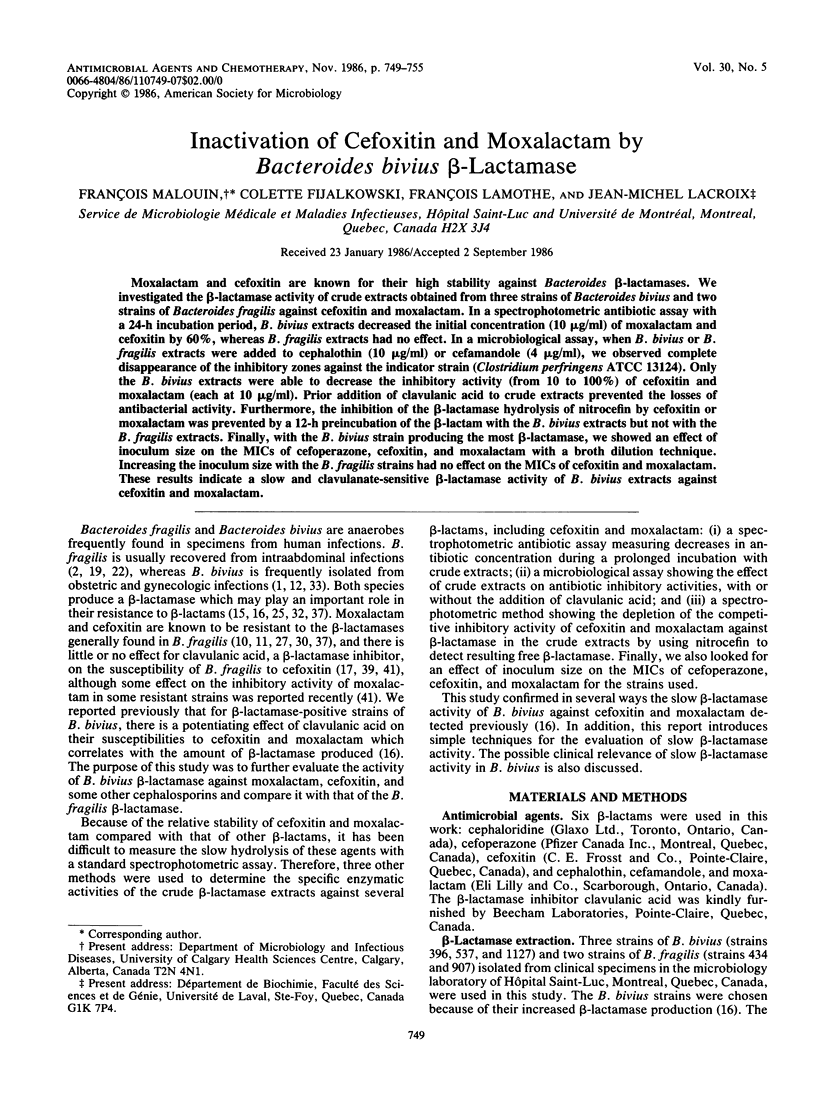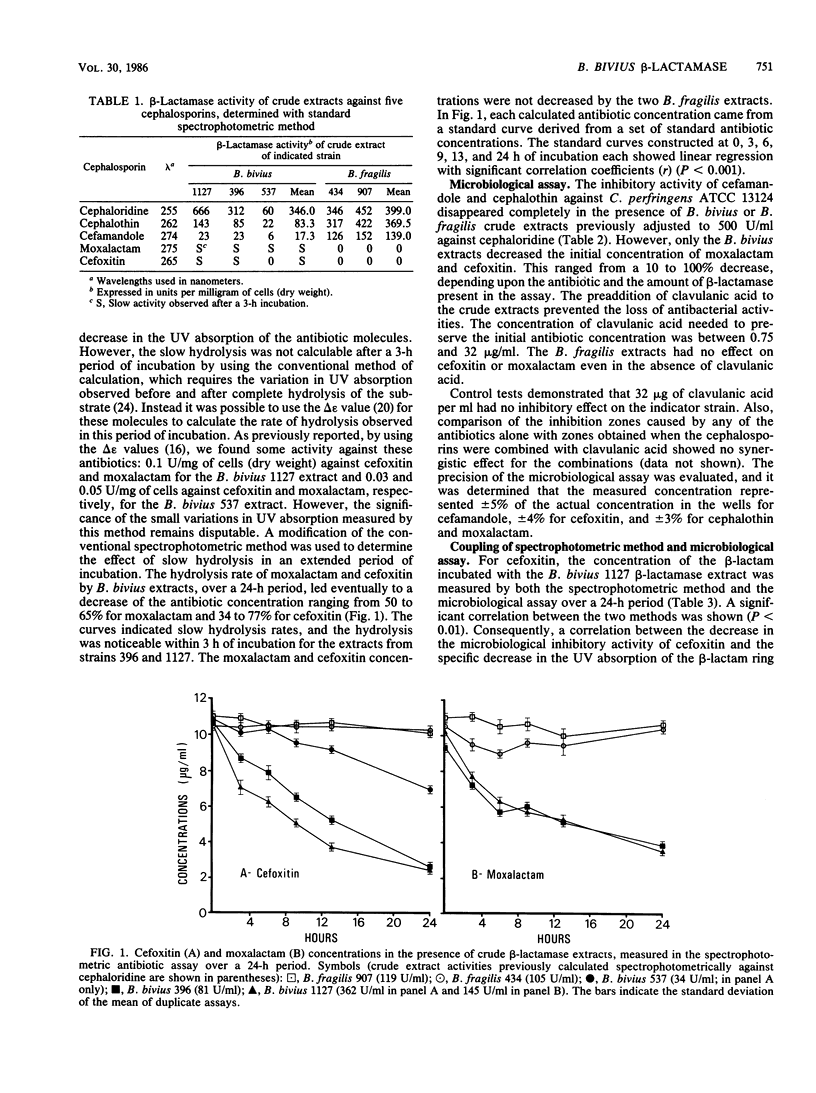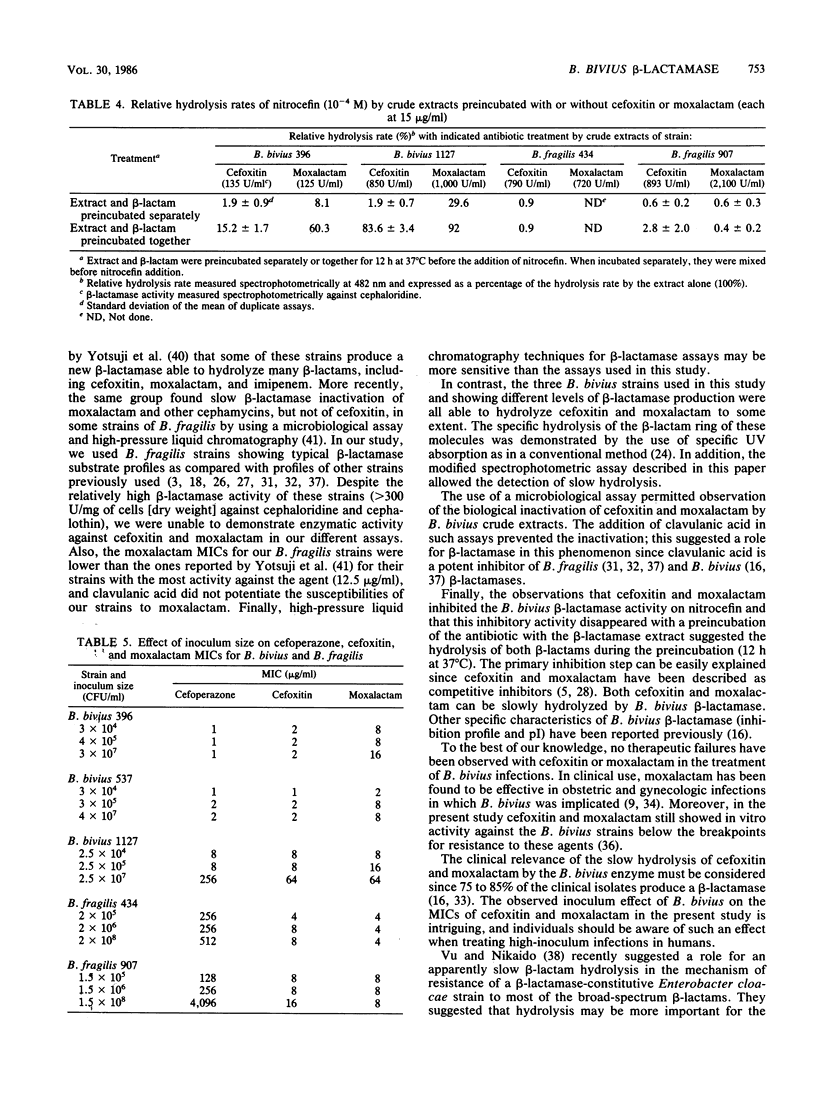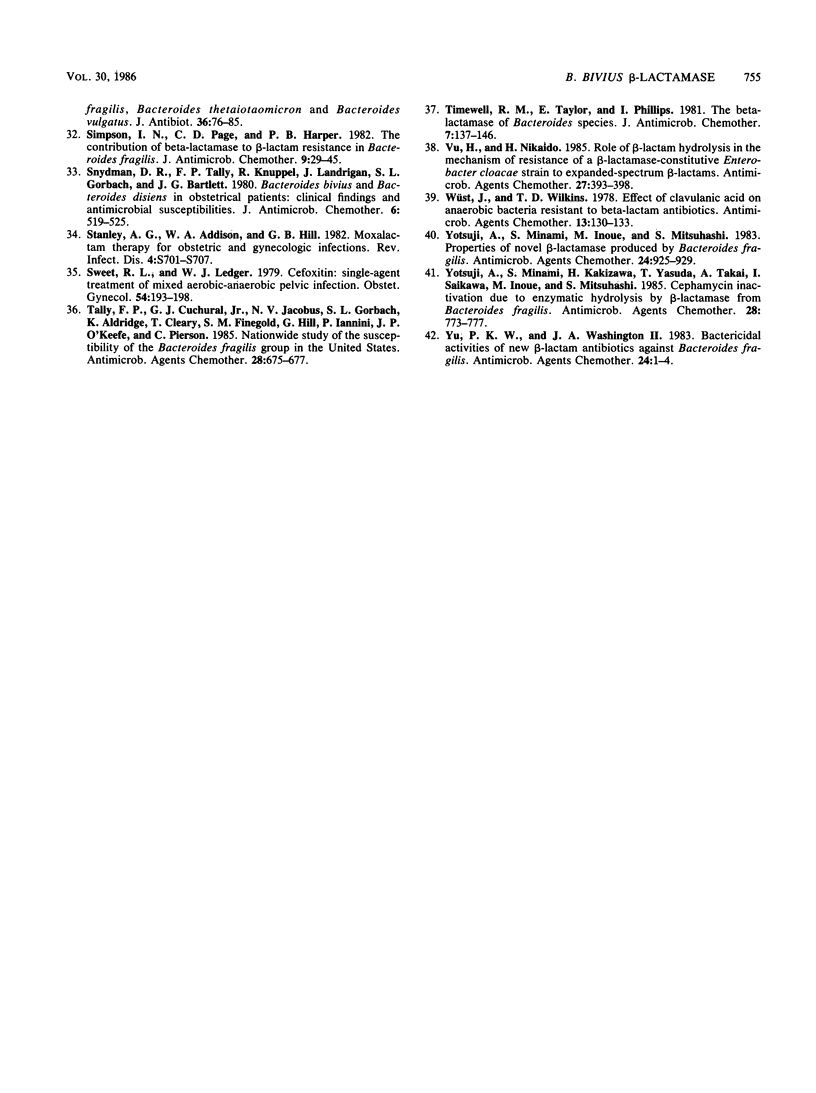Abstract
Moxalactam and cefoxitin are known for their high stability against Bacteroides beta-lactamases. We investigated the beta-lactamase activity of crude extracts obtained from three strains of Bacteroides bivius and two strains of Bacteroides fragilis against cefoxitin and moxalactam. In a spectrophotometric antibiotic assay with a 24-h incubation period, B. bivius extracts decreased the initial concentration (10 micrograms/ml) of moxalactam and cefoxitin by 60%, whereas B. fragilis extracts had no effect. In a microbiological assay, when B. bivius or B. fragilis extracts were added to cephalothin (10 micrograms/ml) or cefamandole (4 micrograms/ml), we observed complete disappearance of the inhibitory zones against the indicator strain (Clostridium perfringens ATCC 13124). Only the B. bivius extracts were able to decrease the inhibitory activity (from 10 to 100%) of cefoxitin and moxalactam (each at 10 micrograms/ml). Prior addition of clavulanic acid to crude extracts prevented the losses of antibacterial activity. Furthermore, the inhibition of the beta-lactamase hydrolysis of nitrocefin by cefoxitin or moxalactam was prevented by a 12-h preincubation of the beta-lactam with the B. bivius extracts but not with the B. fragilis extracts. Finally, with the B. bivius strain producing the most beta-lactamase, we showed an effect of inoculum size on the MICs of cefoperazone, cefoxitin, and moxalactam with a broth dilution technique. Increasing the inoculum size with the B. fragilis strains had no effect on the MISs of cefoxitin and moxalactam. These results indicate a slow and clavulanate-sensitive beta-lactamase activity of B. bivius extracts against cefoxitin and moxalactam.
Full text
PDF






Selected References
These references are in PubMed. This may not be the complete list of references from this article.
- Blanco J. D., Gibbs R. S., Duff P., Castaneda Y. S., St Clair P. J. Randomized comparison of ceftazidime versus clindamycin-tobramycin in the treatment of obstetrical and gynecological infections. Antimicrob Agents Chemother. 1983 Oct;24(4):500–504. doi: 10.1128/aac.24.4.500. [DOI] [PMC free article] [PubMed] [Google Scholar]
- Bodner S. J., Koenig M. G., Goodman J. S. Bacteremic Bacteroides infections. Ann Intern Med. 1970 Oct;73(4):537–544. doi: 10.7326/0003-4819-73-4-537. [DOI] [PubMed] [Google Scholar]
- Britz M. L., Wilkinson R. G. Purification and properties of beta-lactamase from Bacteroides fragilis. Antimicrob Agents Chemother. 1978 Mar;13(3):373–382. doi: 10.1128/aac.13.3.373. [DOI] [PMC free article] [PubMed] [Google Scholar]
- Brown J. E., Del Bene V. E., Collins C. D. In vitro activity of N-formimidoyl thienamycin, moxalactam, and other new beta-lactam agents against Bacteroides fragilis: contribution of beta-lactamase to resistance. Antimicrob Agents Chemother. 1981 Feb;19(2):248–252. doi: 10.1128/aac.19.2.248. [DOI] [PMC free article] [PubMed] [Google Scholar]
- Bush K., Sykes R. B. beta-Lactamase inhibitors in perspective. J Antimicrob Chemother. 1983 Feb;11(2):97–107. doi: 10.1093/jac/11.2.97. [DOI] [PubMed] [Google Scholar]
- Busuttil R. W., McGrattan M. A., Winston D. J. Moxalactam in the treatment of intraabdominal sepsis and other surgical infections. Rev Infect Dis. 1982 Nov-Dec;4 (Suppl):S676–S682. doi: 10.1093/clinids/4.supplement_3.s676. [DOI] [PubMed] [Google Scholar]
- Christensen B. G., Ruswinkle L. J., Cama L. D. The design of new drugs that resist microbial inactivation. Rev Infect Dis. 1979 Jan-Feb;1(1):64–72. doi: 10.1093/clinids/1.1.64. [DOI] [PubMed] [Google Scholar]
- Cuchural G. J., Jr, Tally F. P., Jacobus N. V., Marsh P. K., Mayhew J. W. Cefoxitin inactivation by Bacteroides fragilis. Antimicrob Agents Chemother. 1983 Dec;24(6):936–940. doi: 10.1128/aac.24.6.936. [DOI] [PMC free article] [PubMed] [Google Scholar]
- Cunningham F. G., Gibbs R. S., Hemsell D. L. Moxalactam for treatment of pelvic infections after cesarean delivery. Rev Infect Dis. 1982 Nov-Dec;4 (Suppl):S696–S700. doi: 10.1093/clinids/4.supplement_3.s696. [DOI] [PubMed] [Google Scholar]
- Darland G., Birnbaum J. Cefoxitin resistance to beta-lactamase: a major factor for susceptibility of bacteroides fragilis to the antibiotic. Antimicrob Agents Chemother. 1977 Apr;11(4):725–734. doi: 10.1128/aac.11.4.725. [DOI] [PMC free article] [PubMed] [Google Scholar]
- Fu K. P., Neu H. C. Antibacteroides and beta-lactamase inhibitory activities of moxalactam. J Antimicrob Chemother. 1981 Oct;8(4):337–341. doi: 10.1093/jac/8.4.337. [DOI] [PubMed] [Google Scholar]
- Gall S. A., Addison W. A., Hill G. B. Moxalactam therapy for obstetric and gynecologic infections. Rev Infect Dis. 1982 Nov-Dec;4 (Suppl):S701–S707. doi: 10.1093/clinids/4.supplement_3.s701. [DOI] [PubMed] [Google Scholar]
- Hirai K., Iyobe S., Inoue M., Mitsuhashi S. Purification and properties of a new beta-lactamase from Pseudomonas cepacia. Antimicrob Agents Chemother. 1980 Mar;17(3):355–358. doi: 10.1128/aac.17.3.355. [DOI] [PMC free article] [PubMed] [Google Scholar]
- Jenkins S. G., Birk R. J., Zabransky R. J. Differences in susceptibilities of species of the Bacteroides fragilis group to several beta-lactam antibiotics: indole production as an indicator of resistance. Antimicrob Agents Chemother. 1982 Oct;22(4):628–634. doi: 10.1128/aac.22.4.628. [DOI] [PMC free article] [PubMed] [Google Scholar]
- Lacroix J. M., Lamothe F., Malouin F. Role of Bacteroides bivius beta-lactamase in beta-lactam susceptibility. Antimicrob Agents Chemother. 1984 Nov;26(5):694–698. doi: 10.1128/aac.26.5.694. [DOI] [PMC free article] [PubMed] [Google Scholar]
- Lamothe F., Auger F., Lacroix J. M. Effect of clavulanic acid on the activities of ten beta-lactam agents against members of the Bacteroides fragilis group. Antimicrob Agents Chemother. 1984 May;25(5):662–665. doi: 10.1128/aac.25.5.662. [DOI] [PMC free article] [PubMed] [Google Scholar]
- Leung T., Williams J. D. beta-Lactamases of subspecies of Bacteroides fragilis. J Antimicrob Chemother. 1978 Jul;4(B):47–54. doi: 10.1093/jac/4.suppl_b.47. [DOI] [PubMed] [Google Scholar]
- Minami S., Yotsuji A., Inoue M., Mitsuhashi S. Induction of beta-lactamase by various beta-lactam antibiotics in Enterobacter cloacae. Antimicrob Agents Chemother. 1980 Sep;18(3):382–385. doi: 10.1128/aac.18.3.382. [DOI] [PMC free article] [PubMed] [Google Scholar]
- Nobles E. R., Jr Bacteroides infections. Ann Surg. 1973 May;177(5):601–606. [PMC free article] [PubMed] [Google Scholar]
- O'Callaghan C. H., Morris A., Kirby S. M., Shingler A. H. Novel method for detection of beta-lactamases by using a chromogenic cephalosporin substrate. Antimicrob Agents Chemother. 1972 Apr;1(4):283–288. doi: 10.1128/aac.1.4.283. [DOI] [PMC free article] [PubMed] [Google Scholar]
- Olsson-Liljequist B., Dornbusch K., Nord C. E. Characterization of three different beta-lactamases from the Bacteroides fragilis group. Antimicrob Agents Chemother. 1980 Aug;18(2):220–225. doi: 10.1128/aac.18.2.220. [DOI] [PMC free article] [PubMed] [Google Scholar]
- Olsson B., Dornbusch K., Nord C. E. Factors contributing to resistance to beta-lactam antibiotics in Bacteroides fragilis. Antimicrob Agents Chemother. 1979 Feb;15(2):263–268. doi: 10.1128/aac.15.2.263. [DOI] [PMC free article] [PubMed] [Google Scholar]
- Olsson B., Nord C. E., Wadström T. Formation of beta-lactamase in Bacteroides fragilis: cell-bound and extracellular activity. Antimicrob Agents Chemother. 1976 May;9(5):727–735. doi: 10.1128/aac.9.5.727. [DOI] [PMC free article] [PubMed] [Google Scholar]
- Ramachandran Nair S., Cherubin C. E. Use of cefoxitin sodium in difficult-to-treat infections. J Antimicrob Chemother. 1978 Jul;4(B):167–178. doi: 10.1093/jac/4.suppl_b.167. [DOI] [PubMed] [Google Scholar]
- Richmond M. H. Susceptibility of moxalactam to beta-lactamase. Rev Infect Dis. 1982 Nov-Dec;4 (Suppl):S522–S526. doi: 10.1093/clinids/4.supplement_3.s522. [DOI] [PubMed] [Google Scholar]
- Richmond M. H. The beta-lactamase stability of a novel beta-lactam antibiotic containing a 7 alpha-methoxyoxacephem nucleus. J Antimicrob Chemother. 1980 Jul;6(4):445–453. doi: 10.1093/jac/6.4.445. [DOI] [PubMed] [Google Scholar]
- Sato K., Inoue M., Mitsuhashi S. Activity of beta-lactamase produced by Bacteroides fragilis against newly introduced cephalosporins. Antimicrob Agents Chemother. 1980 Apr;17(4):736–737. doi: 10.1128/aac.17.4.736. [DOI] [PMC free article] [PubMed] [Google Scholar]
- Sato K., Matsuura Y., Miyata K., Inoue M., Mitsuhashi S. Characterization of cephalosporinases from Bacteroides fragilis, Bacteroides thetaiotaomicron and Bacteroides vulgatus. J Antibiot (Tokyo) 1983 Jan;36(1):76–85. doi: 10.7164/antibiotics.36.76. [DOI] [PubMed] [Google Scholar]
- Simpson I. N., Page C. D., Harper P. B. The contribution of beta-lactamases to beta-lactam resistance in Bacteroides fragilis. J Antimicrob Chemother. 1982 Jan;9(1):29–45. doi: 10.1093/jac/9.1.29. [DOI] [PubMed] [Google Scholar]
- Snydman D. R., Tally F. P., Knuppel R., Landrigan J., Gorbach S. L., Bartlett J. G. Bacteroides bivius and Bacteroides disiens in obstetrical patients: clinical findings and antimicrobial susceptibilities. J Antimicrob Chemother. 1980 Jul;6(4):519–525. doi: 10.1093/jac/6.4.519. [DOI] [PubMed] [Google Scholar]
- Sweet R. L., Ledger W. J. Cefoxitin: single-agent treatment of mixed aerobic-anaerobic pelvic infections. Obstet Gynecol. 1979 Aug;54(2):193–198. [PubMed] [Google Scholar]
- Tally F. P., Cuchural G. J., Jr, Jacobus N. V., Gorbach S. L., Aldridge K., Cleary T., Finegold S. M., Hill G., Iannini P., O'Keefe J. P. Nationwide study of the susceptibility of the Bacteroides fragilis group in the United States. Antimicrob Agents Chemother. 1985 Nov;28(5):675–677. doi: 10.1128/aac.28.5.675. [DOI] [PMC free article] [PubMed] [Google Scholar]
- Timewell R., Taylor E., Phillips I. The beta-lactamases of Bacteroides species. J Antimicrob Chemother. 1981 Feb;7(2):137–146. doi: 10.1093/jac/7.2.137. [DOI] [PubMed] [Google Scholar]
- Vu H., Nikaido H. Role of beta-lactam hydrolysis in the mechanism of resistance of a beta-lactamase-constitutive Enterobacter cloacae strain to expanded-spectrum beta-lactams. Antimicrob Agents Chemother. 1985 Mar;27(3):393–398. doi: 10.1128/aac.27.3.393. [DOI] [PMC free article] [PubMed] [Google Scholar]
- Wüst J., Wilkins T. D. Effect of clavulanic Acid on anaerobic bacteria resistant to Beta-lactam antibiotics. Antimicrob Agents Chemother. 1978 Jan;13(1):130–133. doi: 10.1128/aac.13.1.130. [DOI] [PMC free article] [PubMed] [Google Scholar]
- Yotsuji A., Minami S., Inoue M., Mitsuhashi S. Properties of novel beta-lactamase produced by Bacteroides fragilis. Antimicrob Agents Chemother. 1983 Dec;24(6):925–929. doi: 10.1128/aac.24.6.925. [DOI] [PMC free article] [PubMed] [Google Scholar]
- Yotsuji A., Minami S., Kakizawa H., Yasuda T., Takai A., Saikawa I., Inoue M., Mitsuhashi S. Cephamycin inactivation due to enzymatic hydrolysis by beta-lactamase from Bacteroides fragilis. Antimicrob Agents Chemother. 1985 Dec;28(6):773–777. doi: 10.1128/aac.28.6.773. [DOI] [PMC free article] [PubMed] [Google Scholar]


